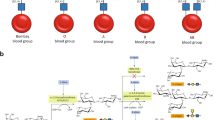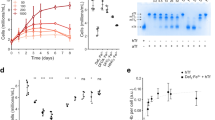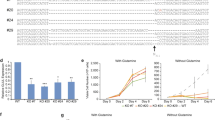Abstract
THE need to develop a blood substitute is now urgent because of the increasing concern over blood-transmitted viral and bacterial pathogens1. Cell-free haemoglobin solutions2,3 and human haemoglobin synthesized in Escherichia coli4 and Saccharomyces cerevisiae5 have been investigated as potential oxygen-carrying substitutes for red blood cells. But these haemoglobins cannot be used as a blood substitute because (1) the oxygen affinity in the absence of 2,3-bisphosphoglycerate is too high to allow unloading of enough oxygen in the tissues6, and (2) they dissociate into αβ dimers7 that are cleared rapidly by renal filtration8–10, which can result in long-term kidney damage7–9. We have produced a human haemoglobin using an expression vector containing one gene encoding a mutant β-globin with decreased oxygen affinity and one duplicated, tandemly fused α-globin gene. Fusion of the two α-globin subunits increases the half-life of this haemoglobin molecule in vivo by preventing its dissociation into αβ dimers and therefore also eliminates renal toxicity.
This is a preview of subscription content, access via your institution
Access options
Subscribe to this journal
Receive 51 print issues and online access
$199.00 per year
only $3.90 per issue
Buy this article
- Purchase on Springer Link
- Instant access to full article PDF
Prices may be subject to local taxes which are calculated during checkout
Similar content being viewed by others
References
Pool, R. Science 250, 1654–1656 (1990).
Moss, G. S., Gould, S. A., Sehgal, H. L., Sehgal, L. R. & Rosen, A. L. Surgery 95, 249–255 (1984).
Mulder, A. G., Amberson, W. R., Steggerda, F. R. & Flexner, J. J. cell. comp. Physiol. 5, 383–397 (1934).
Hoffman, S. J. et al. Proc. natn. Acad. Sci. U.S.A. 87, 8521–8525 (1990).
Wagenbach, M. et al. Biotechnology 9, 57–61 (1991).
Benesch, R. & Benesch, R. E. Biochem. biophys. Res. Commun. 26, 162–167 (1967).
Ackers, G. K. & Halvorson, H. R. Proc. natn. Acad. Sci. U.S.A. 71, 4312–4316 (1974).
Bunn, H. F., Esham, W. & Bull, R. J. J. exp. Med. 129, 909–923 (1969).
Bunn, H. F. & Jandl, J. J. exp. Med. 129, 925–934 (1969).
Lee, R., Atsumi, N., Jacobs, E., Austen, W. & Vlahakes, G. J. Surg. Res. 47, 407–411 (1989).
Fermi, G., Perutz, M., Shaanan, B. & Fourme, R. J. molec. Biol. 175, 159–174 (1984).
Shaanan, B. J. molec. Biol. 171, 31–59 (1983).
Nagai, K., Enoki, Y., Tomita, S. & Teshima, T. J. biol. Chem. 257, 1622–1625 (1982).
Better, J., Chang, P., Robinson, R. & Horwitz, R. Science 240, 1041–1043 (1988).
Skerra, A. & Pluckthorn, A. Science 240, 1038–1041 (1988).
Moo-Penn, W. et al. FEBS Lett. 92, 53–57 (1978).
Bucci, E., Razynska, A., Urbaitis, B. & Fronticelli, C. J. biol. Chem. 264, 6191–6195 (1989).
Snyder, S. R., Welty, E. V., Walder, R. Y., Williams, L. A. & Walder, J. A. Proc. natn. Acad. Sci. U.S.A. 84, 7280–7284 (1987).
Manning, L. R. et al. Proc. natn. Acad. Sci. U.S.A. 88, 3329–3333 (1991).
Loeb, W. F. & Quimby, F. W. (eds) The Clinical Chemistry of Laboratory animals 460–495 (Pergamon, New York, 1989).
Biro, G. P., Ning, J., Peterson, L. M. N. & Anderson, P. J. Biomat. Artificial Cells Immob. Technol. 19, 357 (1991).
Perutz, M. F. J. Crystal Growth 2, 54–56 (1968).
Author information
Authors and Affiliations
Rights and permissions
About this article
Cite this article
Looker, D., Abbott-Brown, D., Cozart, P. et al. A human recombinant haemoglobin designed for use as a blood substitute. Nature 356, 258–260 (1992). https://doi.org/10.1038/356258a0
Received:
Accepted:
Issue Date:
DOI: https://doi.org/10.1038/356258a0
This article is cited by
-
Plant based production of myoglobin - a novel source of the muscle heme-protein
Scientific Reports (2020)
Comments
By submitting a comment you agree to abide by our Terms and Community Guidelines. If you find something abusive or that does not comply with our terms or guidelines please flag it as inappropriate.



